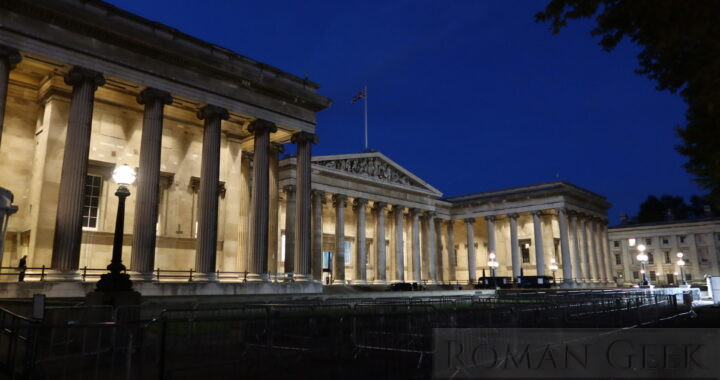- The British Museum is a Museum of Human Culture which contains over 8,000,000 items. It is one of the largest Museums in this category.
Getting there
- Location: Great Russell Street, Bloomsbury, London.
- Nearest Underground Station: Tottenham Court Road, Northern Line, Central Line.
- Admission: Free. Opening Hours: Tuesday to Sunday 1000-1700, closed Mondays, open on Bank Holidays.
Built in the style of a Greek Temple
- The Museum first opened to the Public in 1759, based on the collections of the scientist Sir Hans Sloane.
- In 1823 the architect Sir Robert Smirke designed the present building in the Neoclassical Greek Revival Style, as a quadrangle with four wings. It was completed in 1852.
- The Museum is based on the Temple of Athene Polias at Priene, with 44 Ionic columns 45 ft (14m) high.
- The building rests on a concrete plinth, and is constructed using a cast iron frame filled with brick and faced with Portland stone.
- The Pediment holds 15 allegorical sculptures representing ‘The Progress of Civilisation’.
Ground Floor
Starting from the Main Entrance.
Turn immediately left into the Cloakroom.
It leads into Room 6, turn right into Room 4.
Room 4 Ancient Egypt
- Rosetta Stone (196 BCE)
- The Rosetta Stone is a Stele written in three languages and holds the key to deciphering Egyptian Hieroglyphs.
- Egyptian Sculptures (5,000 BCE-300 CE)
Go through Rooms 8, 23, 17, into 18a, 18b.
Rooms 18a , 18b Ancient Greece ‘Parthenon’
-
- Parthenon (447-438 BCE)
Go back into 17, turn left into 19 and into 20, 21, 22 and 23.
Room 20 Ancient Greece
-
- Xanthos, Turkey.
- Xanthos Tomb of Payava (c. 375-360 BCE)
- A vaulted stone Sarcophagus built for the presumed Persian Ruler of Xanthos, Payava, in Lycia. It has carved reliefs in both Greek and Persian style.
- Xanthos, Turkey.
Room 21 Ancient Greece
-
- Halicarnassus (353-350 BCE)
- The Museum holds in Room 21, Artefacts from the Mausoleum of Mausolus at Halicarnassus, one of the Seven Wonders of the Ancient World.
- On display are Statues, Marble relief slabs and fragments of the Marble Four-horse Chariot that once stood on the roof.
- Halicarnassus (353-350 BCE)
Room 22 Ancient Greece ‘World of Alexander: Greek and Roman Sculpture’
-
- Ephesus (c.323 BCE)
- In Room 22 is a giant column drum with carvings from the Temple of Artemis at Ephesus, one of the Seven Wonders of the Ancient World, also the Demeter from Knidos and a collection of Greek Bronzes.
- Other items from Ephesus are distributed by date and category in the other Rooms.
- Ephesus (c.323 BCE)
Room 23 Ancient Greece ‘Greek and Roman Statues’
-
- Various sculptures which are mostly Roman marble copies of Greek Bronzes which have not survived.
Return to the Main Entrance and climb the South Stairs to the Upper Floor.
Upper Floor
starting anti-clockwise from the South Stairs
Go through Room 40.
Room 41 Sutton Hoo and Europe (from 300-1100 CE)
-
- Roman Lycurgus Cup (c. 360 CE)
Room 49 Ancient Rome ‘Roman Britain Gallery’
-
- Roman Amphorae
- Roman Mosaics
- Roman Hoards (43-410 CE):
- Havering Ring: A 4th century CE Gold Ring with an Intaglio depicting Bellerophon riding Pegasus.
- Hoxne Hoard
- Thetford Hoard
- Mildenhall Treasure
- Capheaton Treasure
- Snettisham Hoard
- Water Newton Treasure
- Vindolanda Tablets
- Thousands of Wax Tablets each containing letters describing Roman Life on Hadrian's Wall
- Ribchester Hoard
- Ribchester Helmet. A ceremonial Roman cavalryman’s helmet which forms part of the Ribchester Hoard.
Go through Rooms 50, 51, 52, turn left through 53, go through 54.
Room 55 Mesopotamia
-
- Venus Tablet (c. 650 BCE)
Go through Room 56 into 57
Room 57 Ancient Levant: ‘Israelites and Phoenicians’
-
- Jewels from Tharros, Sardinia.
- Go through Room 58, turn right into 59. it leads into 61, and 63 leads left into 66.
- Jewels from Tharros, Sardinia.
Rooms 61-66 Ancient Egypt
-
- Amarna Letters (c.1,360-c.1,332 BCE)
- The Amarna Letters, also known as the Amarna Tablets, are a series of 382 Clay Tablets found in Tell el-Amarna, Egypt, the former Egyptian Capital of Pharaoh Akhenaton (c. 1350-1330 BCE).
- Papyrus of Ani
- This is a well preserved example of the Book of the Dead which was discovered in Luxor and is now held in Rooms 62-63.
- Egyptian Mummies (2,686 BCE-395 CE)
- Amarna Letters (c.1,360-c.1,332 BCE)
Go back to Room 61, Room 59 then leads into 73, 72, 71 and 70.
Room 70 Ancient Rome ‘Roman Empire’
-
- The Portland Vase (c.1-25 CE)
- A rare Amphora made in Rome and consisting of a dark blue and opaque white cameo glass, dated to between 1-25 CE. Etched in the white glass are seated men and women.
- The Warren Cup (c.10 CE)
- A Greco-Roman silver drinking goblet with decorated reliefs, dated to 5-15 CE. Acquired in 1999 for £1.8M.
- Collections of Roman Amphorae, Pottery, Sculptures, Coins and Musical Instruments.
- The Portland Vase (c.1-25 CE)
Room 70 leads into Room 69.
Room 69 Ancient Greece ‘Greek and Roman Life’
-
- Satala, Turkey
- The Satala Aphrodite (c. 1st century BCE).
- This is the Bronze Head of a statue of Aphrodite from Satala, which was acquired in 1873 by the British Museum.
- The Satala Aphrodite (c. 1st century BCE).
- Xanthos, Turkey
- Xanthos Nereid Monument (c. 380 BCE)
- A Tomb built in c. 380 BCE for a King of Lycia in the style of a Greek Temple on a podium.
- Xanthos Nereid Monument (c. 380 BCE)
- Satala, Turkey
Go through Room 68 and The Coffee Lounge is opposite the South Stairs, overlooking the Great Court. There are another two Cafes in the Great Court below.
Photo and map: British Museum, Great Russell Street

